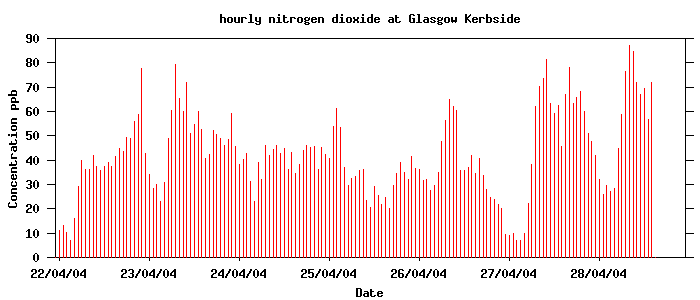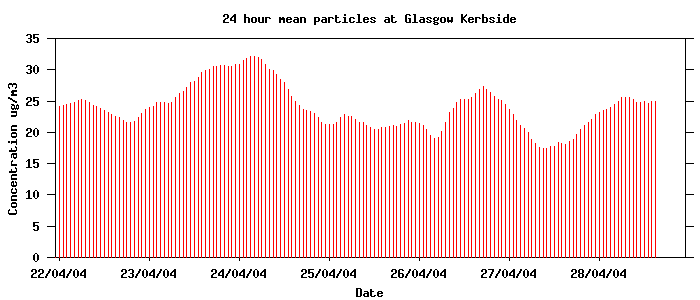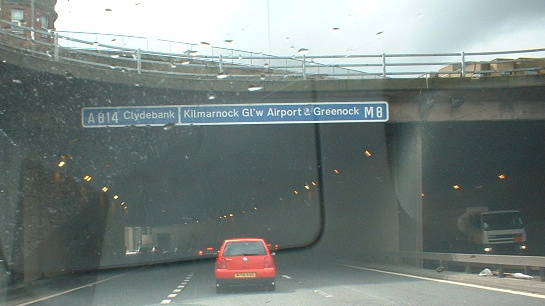
| Previous | Home | Next |
Contents
Air Quality Within Glasgow City Centre
Pollutants
In January 2002, Glasgow city declared itself an Air Quality Management Area. This meant that it had exceeded Government 'Safe' levels of certain pollutants, namely Nitrogen Dioxide and PM10 particles. Exposure to high levels of these polutants can have serious detremental effects to human health. Nitrogen dioxide can irritate the lungs and lower resistance to respiratory infections such as influenza. Continued or frequent exposure to concentrations that are typically much higher than those normally found in the ambient air may cause increased incidence of acute respiratory illness in children. In Glasgow alone an estimated yearly average of 90% Nitrogen Dioxide emissions come from traffic. Similarly, the principal source of airborne PM10 (the fraction of particles < 10micro m) is road traffic emissions, particularly from diesel vehicles. Fine particles are small enough to penetrate deep into the lungs where they can cause inflammation and worsening of the condition of people with heart and lung disease. In addition, they may carry surface-absorbed carcinogenic compounds into the lungs.
Government Objectives
Government Objectives have been set and new lower levels for both of these pollutants have been outlined. They are as follows: Nitrogen Dioxide levels should not exceed 40micro grams/m3 as an annual mean, by Dec. 2005. Also, hourly means should not exceed 200micro grams/m3 and this figure should not be exceeded more than 18 times per year. PM10 particle levels should not exceed 50micro grams/m3 measured as 24hour mean, not to be exceeded more than 7 times per year, by Dec. 2010. Annual mean of 18micro grams/m3 should be achieved.
Monitoring Glasgow's Air Quality
There are 3 monitoring sites within the city centre; Hope Street represents the Kerbside being situated within 1m of the edge of a busy road where it is subject to frequent congestion during peak traffic flow periods. Montrose Street is representative of background city pollution levels, situated 20metres above ground level to the rear of the city chambers. Finally, St.Enoch Square is representative of typical population exposure in town located 10metres from the nearest road.
We have monitored the hourly concentration of nitrogen dioxide and PM10 particles throughout the city centre over the past weeks. The graphs below show the levels for both pollutants over the past week. The levels for both remain high. It is evident that drastic action must be taken to reduce these figures in order to satisfy the Government objectives.


The levels of pollutants monitored from Glasgow's three sites can be viewed on The Air Quality Archive website.
High Emissions, High Pollution
The over whelming amount of road traffic on Glasgow's roads is by far the biggest contributor to the high levels of Nitrogen Dioxide and PM10 particles, especially within the city centre. A study conducted in 2000 by DEFRA, for Glasgow City Council, showed that an enormous 90% of Nitrogen Dioxide emissions for that year alone came from road traffic. A table of these emission levels can be viewed here.
The picture below is from Charing Cross and represents the worst air polluted area in Glasgow. Engineers responsible for the up-keep of this stretch of motorway have identified this as a particularly poor air quality area and do not allow their team to work on this area for periods of more than 15minutes at a time. They feel that anything more could potentially effect the health of their workers.
 Top
Top
© 2004 All rights reserved. Copyright of Derek Weir, Leanne McMillan, Roy MacLean, Hee Dong Oh & Ayman Elsadig
| Previous | Home | Next |